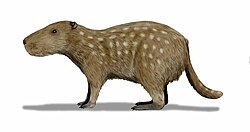This article relies largely or entirely on a single source .(September 2021) |
| Petromus | |
|---|---|
 | |
| Dassie rat (Petromus typicus) | |
| Scientific classification | |
| Domain: | Eukaryota |
| Kingdom: | Animalia |
| Phylum: | Chordata |
| Class: | Mammalia |
| Order: | Rodentia |
| Family: | Petromuridae |
| Genus: | Petromus A. Smith, 1831 |
| Type species | |
| Petromus typicus A. Smith, 1831 | |
| Species | |
Petromus is a genus of hystricognath rodents that contains the dassie rat (Petromus typicus) of southwestern Africa, the only extant member of this group and the entire family Petromuridae.
Two fossil species are known from the Pliocene, with the oldest being Petromus antiquus of the Early Pliocene. [1]














